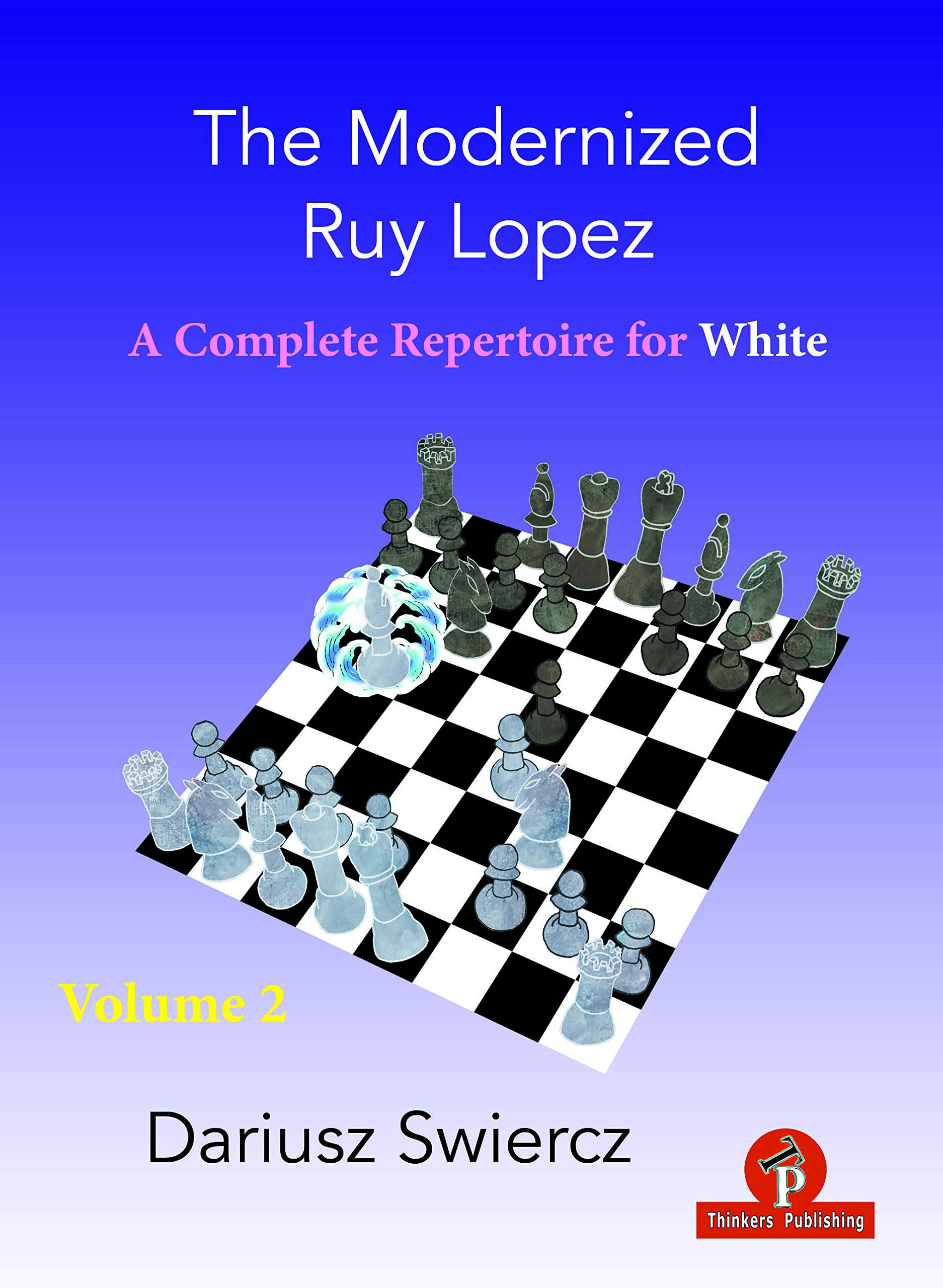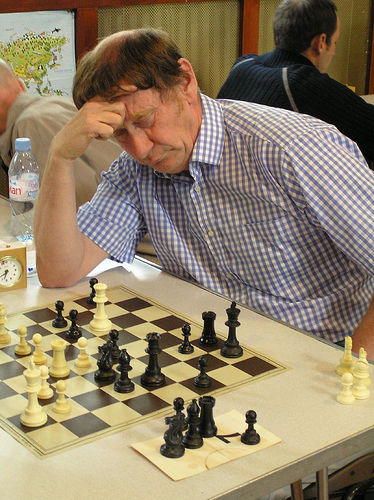
“Dariusz Swiercz was born in 1994 in Tarnowskie Gory, Poland. His grandfather taught him to play chess at the age of three. During his junior career he won numerous National Championships as well as several European and World Championship medals. His highest successes include the bronze medal in 2010 at the World U20 Championship (Chotowa, Poland), gold medal in 2011 at the World U20 Championship (Chennai, India) and another gold medal in 2012 at the World U18 Championship (Maribor, Slovenia). He is one of the youngest to receive the Grandmaster title at the age of 14 years and 7 months. In 2016 he won the third edition of the “Millionaire Chess” held in Las Vegas, USA. Since 2018 he has represented the United States. Dariusz currently resides in Saint Louis, Missouri.”

From the book’s rear cover we have this extensive blurb:
“I would like to thank you for purchasing this book, I really appreciate it. It also means that you found an interest in my work of trying to crack the Ruy Lopez. As I said in the introduction to the first volume, I had no idea what I was signing up for when deciding to write a book on Ruy Lopez. This opening has such a rich history and good reputation that proving advantages in many lines is nearly impossible.
Writing the first volume on this opening was a Herculean effort and I thought “it cannot be more difficult”. After all, I was covering such solid variations as the Berlin and the Open Spanish. Well, I got surprised again! I am not exaggerating when I say that writing the second volume was at least as hard as writing the first one. This second volume on the Ruy Lopez consists of two parts. In the first part I focus on modern systems with …Bc5, attempting to dissect both the Archangelsk and Moller Variations. These two variations have quite a rich history but in 2020 there have been several developments. If I had to name one person that contributed the most to the developments in those lines it is, without a doubt, Fabiano Caruana. His encounters in the Candidates Tournament in Ekaterinburg, then his theoretical discussion in those lines with Leinier Dominguez, revised my opinion on many of those lines and led to interesting discoveries that I analyse in this book.
In the subsequent part I discuss the Closed Ruy Lopez. It is easily one of the most popular openings throughout the history of chess with many games occurring as early as the 1800s. I suggest going for 9.h3 which usually leads to a positional battle. I present new trends and find new paths and ideas in such evergreen variations as the Zaitsev, Breyer, Chigorin and others. Additionally, I attempt to crack the Marshall Attack by suggesting the Anti-Marshall lines with 8.a4. I must admit that I thought that it would be a pretty easy task to analyse those openings having some prior analysis and experience with both colours. However, time after time I was encountering new challenges and new ideas from both sides that I had to resolve. My conclusions, based on careful analysis with the most powerful engines currently available is presented in this book.
This book completes my series on the Ruy Lopez. I would like to take a moment and recall what I said in the introduction to the first volume. When both sides play very good and sound chess, it is normal that games end in a draw. It is especially true for such sound openings as Ruy Lopez. I do not attempt to dismiss one line or another because somewhere with best play Black can make a draw by force on move number 30, playing sometimes ridiculous moves that are only found during the analytical work. Over the board the reality is way different – practical aspect plays an important role in chess. Some positions are easier to play, some harder. Similarly to what I did in the first volume, I try to offer the most playable positions.
I do not mind if the positions are equal, provided it is easier to play with White or the chance of an error by Black is quite large. Sometimes I go into forced variations (e.g. in Moller Defense or Archangelsk Defense), sometimes into more positional battles (like in the Zaitsev) but I truly believe that the positions I aim to reach have potential and are tricky for Black. With proper knowledge I think White can put pressure on Black in the Ruy Lopez. I hope that you will find my approach to tackling the Ruy Lopez interesting. I am aware that there is only so much I can analyse and someone may say that I did not analyse some positions deeply enough but that is the nature of chess – possibilities are pretty much unlimited and there will always be theoretical debate!
Finally, I wish you, dear Reader, good luck and I hope you can successfully use the ideas that I present in this book in your games. Dariusz Swiercz February 2021.”
End of blurb…
Volume 1 of this series was previously reviewed here.
In Volume 2 the author looks at the major lines against the Lopez and he breaks the content down into three parts.
Before continuing it would be worth looking at this 19 page excerpt from the book.
Part 1 starts with systems with …Bc5 including the Møller defence.
After 1.e4 e5 2.Nf3 Nc6 3.Bb5 a6 4.Ba4 Nf6 5.00 Bc5 a move played by World Champion Magnus Carlsen in a few games but more regularly championed by Alexander Onischuk. White continues with 6.c3 which is the most popular move according to my database.
In the game Nepomniachtchi v Caruana the game went 6…0-0 7.d4 Ba7 8.Re1
and White plans to bring his bishop to e3. He can also try 8.Bg5 as Lev Aronian did in a game vs Magnus. White is trying to pressurise e5 and get black to exchange on d4. After 8…d6 9 h3 b5 10 Bc2 when Be3 is coming and White usually tries to play his Knight to f5 with king side pressure.
On 6…b5 7.Bc2 d5 8.a4 will surprise black players. After 8…Rb8 9.ab5 ab5 10.d4 de4 11.dc5 Qd1 12.Bd1 ef3 13.Bf3 e4 14.Be2 when Stockfish gives White as much better since he retains the bishop pair.
Black can try 8…de4 9.ab5 00 but 10 Ng5 ! seems to leave White better. As in many lines analysis is given up to move 25 !
This whole line is very tricky and both players need to know it well. The Archangelsk with 5…b5 6 Bb3 completes Part 1 with the older move 6…Bb7 being looked at first and then 7 Re1 is given first. Having played this in many online games I as black I believe this is Whites best move now and ….Be7 is rather condemned. White can just play as he does against the Closed but he can save a tempo on h3 as there is no Bg4 move.
The modern 6…Bc5 played by Fabio Caruana and Gata Kamsky is given when 7 a4 should set black thinking. First 7…b4 is dismissed as an error as 8 Ne5! Ne5 9 d4 is good for White. Better are both 7…Bb7 and …Rb8 though White will continue his plan of building a big pawn centre with c3 and d4. In many of these lines white follows up with Bg5 when h6 Bh4 g5 can often be met with Nxg5 ideas.
Part 2 comprises the so-called main line of 5…Be7 6 Re1 b5 7 Bb3 d6 8 c3 00 9 h3
when 9…a5 is the Keres variation, 9…Be6 the Kholmov variation, 9…Nd7 the Karpov and both 9…Qd7 and 9…h6 credited to Smyslov.
For the first three variations 10.d4 followed by d5 attempting to cramp black are investigated but 9…Qd7 10 d4 Re8 11 Bg5 and 9…h6 10 d4 Re8 11 Nbd2 Bf8 12 Nf1 are both given as gaining an advantage for White .
Against the Zaitzev variation (9…Bb7) white has a plan of d4 combined with a3 and Bc2 followed by b3. He must be well prepared for black to play d5 here .
The Chigorin variation (9…Na5) was a favourite of Paul Keres and following 10 Bc2 c5 11 d4
both …Qc7 and …Nd7 are looked at in detail with 12 d5 recommended against both, again trying to cramp black.
12.d5 seems better than 12 Nbd2 when black can exchange on d4 and play for pressure on e4.
The Breyer variation (9…Nb8 ) as essayed by Anatoly Karpov sees 10 d4 Nbd7 11 c4 !? a move that will probably surprise Black.
For recommendations to deal with the Marshall Attack you will need to buy the book!
The book winds up in Part 3 by looking at 5…Be7 6.d3 for players who don’t want to get involved in too much opening theory.
Generally this is a book for those who take chess very seriously and are not frightened of learning large quantities of opening theory. The book is written from White’s perspective and therefore does not include a treatment of the exchange variation.
It is also good for postal /correspondence chess as White usually ends up with an edge so can torture his opponent for some time.
Colin Lyne, Farnborough, Hampshire, 26th May, 2021

Book Details :
- Paperback : 336 pages
- Publisher:Thinkers Publishing; 1st edition (13 April 2021)
- Language: English
- ISBN-10:9464201088
- ISBN-13:978-9464201086
- Product Dimensions: 17.02 x 23.5 cm
Official web site of Thinkers Publishing

